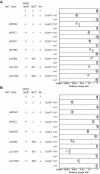Type III restriction is alleviated by bacteriophage (RecE) homologous recombination function but enhanced by bacterial (RecBCD) function
- PMID: 16237019
- PMCID: PMC1272966
- DOI: 10.1128/JB.187.21.7362-7373.2005
Type III restriction is alleviated by bacteriophage (RecE) homologous recombination function but enhanced by bacterial (RecBCD) function
Erratum in
- J Bacteriol. 2007 Feb;189(3):1180
Abstract
Previous works have demonstrated that DNA breaks generated by restriction enzymes stimulate, and are repaired by, homologous recombination with an intact, homologous DNA region through the function of lambdoid bacteriophages lambda and Rac. In the present work, we examined the effect of bacteriophage functions, expressed in bacterial cells, on restriction of an infecting tester phage in a simple plaque formation assay. The efficiency of plaque formation on an Escherichia coli host carrying EcoRI, a type II restriction system, is not increased by the presence of Rac prophage-presumably because, under the single-infection conditions of the plaque assay, a broken phage DNA cannot find a homologue with which to recombine. To our surprise, however, we found that the efficiency of plaque formation in the presence of a type III restriction system, EcoP1 or EcoP15, is increased by the bacteriophage-mediated homologous recombination functions recE and recT of Rac prophage. This type III restriction alleviation does not depend on lar on Rac, unlike type I restriction alleviation. On the other hand, bacterial RecBCD-homologous recombination function enhances type III restriction. These results led us to hypothesize that the action of type III restriction enzymes takes place on replicated or replicating DNA in vivo and leaves daughter DNAs with breaks at nonallelic sites, that bacteriophage-mediated homologous recombination reconstitutes an intact DNA from them, and that RecBCD exonuclease blocks this repair by degradation from the restriction breaks.
Figures








Similar articles
-
Bacteriophage P22 Abc2 protein binds to RecC increases the 5' strand nicking activity of RecBCD and together with lambda bet, promotes Chi-independent recombination.J Mol Biol. 2000 Feb 18;296(2):385-401. doi: 10.1006/jmbi.1999.3486. J Mol Biol. 2000. PMID: 10669596
-
Modulation of EcoKI restriction in vivo: role of the lambda Gam protein and plasmid metabolism.J Bacteriol. 1997 Mar;179(6):1852-6. doi: 10.1128/jb.179.6.1852-1856.1997. J Bacteriol. 1997. PMID: 9068628 Free PMC article.
-
Genetic and molecular analyses of the C-terminal region of the recE gene from the Rac prophage of Escherichia coli K-12 reveal the recT gene.J Bacteriol. 1993 Dec;175(23):7673-82. doi: 10.1128/jb.175.23.7673-7682.1993. J Bacteriol. 1993. PMID: 8244937 Free PMC article.
-
Homologous recombination in prokaryotes: enzymes and controlling sites.Genome. 1989;31(2):520-7. doi: 10.1139/g89-100. Genome. 1989. PMID: 2534386 Review.
-
What makes the bacteriophage lambda Red system useful for genetic engineering: molecular mechanism and biological function.FEMS Microbiol Lett. 2001 Jul 10;201(1):9-14. doi: 10.1111/j.1574-6968.2001.tb10725.x. FEMS Microbiol Lett. 2001. PMID: 11445160 Review.
Cited by
-
Evolution of DNA double-strand break repair by gene conversion: coevolution between a phage and a restriction-modification system.Genetics. 2007 May;176(1):513-26. doi: 10.1534/genetics.106.056150. Epub 2007 Apr 3. Genetics. 2007. PMID: 17409094 Free PMC article.
-
Cleavage of a model DNA replication fork by a methyl-specific endonuclease.Nucleic Acids Res. 2011 Jul;39(13):5489-98. doi: 10.1093/nar/gkr153. Epub 2011 Mar 26. Nucleic Acids Res. 2011. PMID: 21441537 Free PMC article.
-
Restriction glycosylases: involvement of endonuclease activities in the restriction process.Nucleic Acids Res. 2017 Feb 17;45(3):1392-1403. doi: 10.1093/nar/gkw1250. Nucleic Acids Res. 2017. PMID: 28180312 Free PMC article.
-
Gene-gene relationships in an Escherichia coli accessory genome are linked to function and mobility.Microb Genom. 2021 Sep;7(9):000650. doi: 10.1099/mgen.0.000650. Microb Genom. 2021. PMID: 34499026 Free PMC article.
-
Physiological Function of Rac Prophage During Biofilm Formation and Regulation of Rac Excision in Escherichia coli K-12.Sci Rep. 2015 Nov 4;5:16074. doi: 10.1038/srep16074. Sci Rep. 2015. PMID: 26530864 Free PMC article.
References
-
- Bachi, B., J. Reiser, and V. Pirrotta. 1979. Methylation and cleavage sequences of the EcoP1 restriction-modification enzyme. J. Mol. Biol. 128: 143-163. - PubMed
-
- Bachmann, B. J. 1987. Derivation and genotypes of some mutant derivatives of Escherichia coli K-12, p. 1190-1219. In F. C. Neidhardt, J. L. Ingraham, K. B. Low, B. Magasanik, M. Schaechter, and H. E. Umbarger (ed.), Escherichia coli and Salmonella typhimurium: cellular and molecular biology, vol. 2. American Society for Microbiology, Washington, D.C.
Publication types
MeSH terms
Substances
LinkOut - more resources
Full Text Sources
Other Literature Sources
Molecular Biology Databases
Miscellaneous

